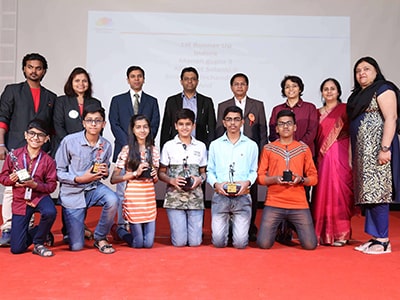Download our FREE Academic Calendar now! 📚 Start your child’s journey to success.
One of the activities that will promote the development of early reading skills is picture reading. Picture reading is always enjoyable, in addition to fostering abilities in observation, visual thinking, reading confidence, and analytical thinking.
What are Picture Talk Activities?
One image is used in picture talk to start a class conversation. It can be something outrageous, made up, or related to a subject you need to discuss, like sports or family.
With this technique in an international school in Ahmedabad, arbitrary groupings of images are used to spark students’ imaginations, tap into their global knowledge, and ultimately translate it into desirable language abilities. This approach can be used on its own or in conjunction with other techniques for teaching languages.
What are the benefits of picture reading activities for kids
Develop oral language skills
Children can practise sounding out language when reading picture books during story time, at home or in the classroom, while adults define and introduce new and intriguing terms. Picture books are easy to understand and fun to read aloud, which helps kids pick up language quickly. Furthermore, reading the same narrative over and over again boosts vocabulary by 12%.
Recognize sequences
Kids can practise understanding what they read by sorting the order of events in a tale. Knowing the story’s beginning, middle, and end and summarising the important events that occur throughout the course of the narrative can help you master this skill.
Visual aids and images help the reader recall the main events of the story and support their capacity to do so with assurance. Allow students to look at the photographs to refresh their memories of the events while they practise sequencing. Use the chance to reread the passage if they guess and guess incorrectly. This presents an opportunity to do an additional understanding check.
Enhance comprehension
On the path to mastering reading, there is a lot to learn. There are numerous more crucial abilities youngsters need to learn in addition to sequencing and summarising in order to understand the content they read. Sentence construction, problem solving, comparing and contrasting, drawing inferences, and more are a few of these abilities.
Make reading a passion
Reading picture books should always be enjoyable. The transition from picture books to chapter books may be hampered if a child has a negative first reading experience and views reading as a chore rather than as something enjoyable.
Develop social-emotional skills
Teaching young children that learning is enjoyable is one of the primary objectives of a picture book.
By creating a routine (such as a bedtime tale), you may make reading something your child looks forward to doing. Along with spending quality time with your child, you will also be assisting in their future preparation. A child’s level of preparation for school can be raised with the use of picture books.
Useful in reading and writing
Most wordless picture books provide as inspiration for these traits. The task of deciphering the meaning that each picture is trying to express will fall to your youngster. This encourages them to think about novel concepts as they absorb information from the first page before turning to the next.
Useful in literacy development
A picture book’s text contains a diverse array of both images and words. These pages accomplish more than merely hold your child’s interest. Additionally, it aids with your child’s ability to connect the words and images. As a result, your child’s vocabulary grows.
You can use it as a jumping off point to teach your child to be bilingual or multilingual at a young age since other picture books are available in more than one language.
Enhance speech
Kids learn to identify sounds and patterns in spoken language when they start to speak and construct sentences. This is the basis for learning to read and is known as phonological awareness. The rhythmic cadence of many picture books helps kids acquire and practise phonological awareness. Children may begin by reciting sections from their favourite picture books before creating new rhymes or tales that are similar to those already existing ones.
Picture talk Activity for Students in Schools
Picture-based group discussion
A candidate’s competencies, including leadership, communication, social and behavioural skills, courtesies, teamwork, listening skills, general awareness, self-assurance, and problem-solving ability, are assessed during the group discussion (GD).
Typically, the group discussion follows the professional degree admission exam. The group discussion may be the first or the last phase in the hiring process, depending on the businesses or organisations.
Visual storytelling
Visual storytelling is the use of graphics, visuals, photos, and videos to captivate audiences and elicit strong feelings, promote dialogue, and inspire action.
Picture-based conversation
One image is used in Picture Talk to start a class conversation. It can be something outlandish, made up, or related to a subject you need to discuss, like sports or family. It has been discovered that basic images frequently work best since they encourage kids to be more creative.
Describing a photo
A written caption that describes the important details of a picture is called an image description. Images, including pictures, graphics, animated GIFs, and videos, can all be described using image descriptions.
Picture-based sentence construction
A visual sentence is a considerably shorter writing exercise that is sparked by a single, simple image.
Picture-based word game
In picture-based word game, a word is created by the player “reading” two images. A picture of an ear and a ring will make the puzzle “Earring,” while a photo of a knight and a mare will make the puzzle “Nightmare,” or the puzzles might be based on how the pictures sound (A picture of a taxi and dough will form Tuxedo).
Conclusion
Everyone is aware of children’s enjoyment of play in preschool in Ahmedabad. Why not use that fun to learn instead? This list of preschool reading activities is a fantastic place to start for introducing kids to letters and creating a foundation for lifelong learning!
FAQ
What is the purpose of picture reading?
Ans – Children’s picture reading and writing skills can be enhanced through picture comprehension. It is a fun approach to encourage kids to read and improve their comprehension skills. By describing what is seen or happening in the picture in short terms, they can start to understand how to continue reading.
What is an example of picture talk?
Ans – Discuss the character’s motivations, past experiences, potential future events, possible course of action, and available options.
How does the school conduct picture talk?
Ans – Teachers can use pictures to show students current events and encourage them to conduct their own research on the pictures while they are in class. Teachers can elicit in-depth thought from students as they reflect on the difficulties the image portrays by showing an image in the classroom.
What is picture talk in oral communication?
Ans – It consists of instantly recognisable word graphics that any user may recognise. It aids in the communication and social interaction of children with communication disorders.
What is picture communication called?
Ans – People who speak no or little spoken language have a different means of communication thanks to visual communication. People’s communication abilities can also be improved by using pictures.
Why are pictures important in communication?
Ans – Pictures are thought of as a simple and efficient form of communication. They attract notice, get people’s attention, pique conversation, aid in the recall of events, and ultimately aid in the organisation of ideas and thoughts.





































